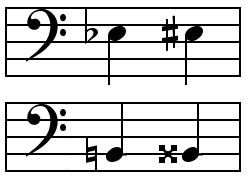Adjacent Keys - keys on a piano that are located directly to the right or left of each other. For example the C key is adjacent to both B & C#.
In the above image, the keys that touch one another are adjacent. Each adjacent key forms a semitone/half-step.
Semitone/Half-step - adjacent keys on the piano keyboard are semitones or half-tones.
Diatonic Semitone (DST) - a semitone in which one note of the semitone is written on a line and the other is written on a space on the staff or vice versa.
These two notes for a diatonic semitone.
These notes also form a DST.
Chromatic Semitone (CST) - a semitone in which both notes are on the same line or space of the staff.
Both of these are examples of CST's.
Accidentals: 
The double sharp raises a pitch two semitones.
The sharp raises a pitch one semitone.
The natural cancels any preceding accidentals, returning to the original pitch.
The flat lowers a pitch one semitone.
The double flat lowers a pitch two semitones.
Whole Tone/Whole Step - Two semitones form a whole tone or a whole step.
- On the above keyboard, a whole tone occurs every other key.
Both of these note whole tones. There are two semitones between A and B as well as between E and F 
This is another way to notate whole tones. Again, there are two semitones between Eb and E# as well as between B and B double-sharp.
The Major Scale Form - the major scale is made up of 8 scale degrees. It consists of five whole tones and two semitones. The whole tones are located between degress 1 & 2, 2 & 3, 4 & 5, 5 & 6, and 6 & 7; the semitones are located between degrees 3 & 4 and 7 & 8.
Scale Degrees - are noted with the carret (^) above the degree number.
Note the semitones between 3 & 4 and 7 & 8 are DSTs. The whole tones otherwise noted are called diatonic whole tones and like diatonic semitones, they are whole tones that occur with one note on a line and the other note on a space.
Tonic - the tonic is the first and the eighth degree of the scale. These two pitches are an octave apart and therefore have the same note name.
If you were to write out the names of the notes in a scale, you would be spelling the scale. For example to spell the Bb Major scale you would write Bb C D Eb F G A Bb. Notice the DSTs between D and Eb and A and Bb, making this scale major.
21.4.08
Whole Tones, Semitones, Accidentals & The Major Scale
Labels:
accidental,
carret,
double flat,
double sharp,
flat,
major scale,
natural,
scale degrees,
semitone,
sharp,
spelling scales,
tonic,
whole tone
Subscribe to:
Post Comments (Atom)
No comments:
Post a Comment